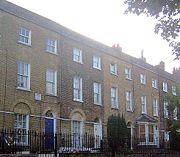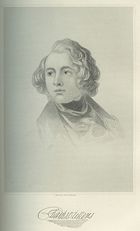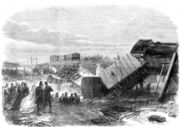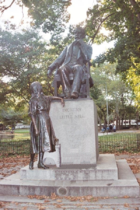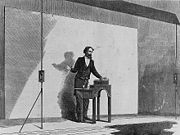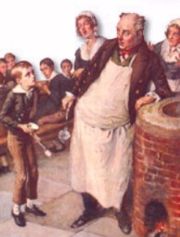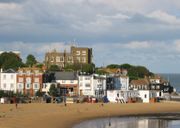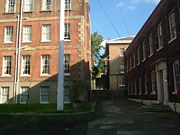Charles Dickens
2008/9 Schools Wikipedia Selection. Related subjects: Writers and critics
| Charles Dickens | |
|---|---|
 Charles Dickens is acclaimed as one of history's greatest novelists |
|
| Born | Charles John Huffam Dickens 7 February 1812 Portsmouth, England |
| Died | 9 June 1870 (aged 58) Gad's Hill Place, Higham, Kent, England |
| Occupation | Novelist |
| Notable work(s) | Oliver Twist, A Christmas Carol, A Tale of Two Cities |
|
Influences
|
|
|
Influenced
|
|
| Signature | |
Charles John Huffam Dickens, FRSA (IPA: /ˈtʃɑrlz ˈdɪkɪnz/; 7 February 1812 – 9 June 1870), pen-name "Boz", was one of the most popular English novelists of the Victorian era as well as a vigorous social campaigner.
Critics George Gissing and G. K. Chesterton championed Dickens's mastery of prose, his endless invention of unique, clever personalities, and his powerful social sensibilities, but fellow writers such as George Henry Lewes, Henry James, and Virginia Woolf faulted his work for sentimentality, implausible occurrences, and grotesque characterizations.
Many of Dickens's novels first appeared in periodicals and magazines in serialized form—a popular format for fiction at the time—and, unlike many other authors who completed entire novels before serial production commenced, Dickens often composed his works in parts, in the order in which they were meant to appear. Such a practice lent his stories a particular rhythm, punctuated by one minor " cliffhanger" after another, to keep the (original) public looking forward to the next installment.
Life
Early years
Charles Dickens was born on 7 February 1812, in Landport, Portsmouth, in Hampshire, the second of eight children to John Dickens (1786–1851), a clerk in the Navy Pay Office at Portsmouth, and his wife, Elizabeth (née Barrow, 1789–1863). When he was five, the family moved to Chatham, Kent. In 1822, when he was ten, the family relocated to 16 Bayham Street, Camden Town, in London.
Although his early years seem to have been an idyllic time, he thought himself then as a "very small and not-over-particularly-taken-care-of boy". He spent time outdoors, but also read voraciously, with a particular fondness for the picaresque novels of Tobias Smollett and Henry Fielding. He talked, later in life, of his extremely poignant memories of childhood, and of his continuing photographic memory of the people and events that helped to bring his fiction to life. His family's early, moderate wealth provided the boy Dickens with some private education at William Giles's school, in Chatham. This time of prosperity came to an abrupt end, however, when his father, after having spent beyond his means in entertaining, and in retaining his social position, was imprisoned at Marshalsea debtors' prison. Shortly afterward, the rest of his family (except for Charles, who boarded nearby), realizing no other option, joined him in residence at Marshalsea.
Just before his father's arrest, the 12-year-old Dickens had begun working ten-hour days at Warren's Blacking Warehouse, on Hungerford Stairs, near the present Charing Cross railway station. He earned six shillings a week pasting labels on jars of thick shoe polish. This money paid for his lodgings at the house of family friend, Elizabeth Roylance, and helped support his family. Mrs. Roylance, Dickens later wrote, was "a reduced old lady, long known to our family," and whom he eventually immortalized, "with a few alterations and embellishments," as "Mrs. Pipchin," in Dombey & Son. Later, lodgings were found for him in a "back-attic...at the house of an insolvent-court agent, who lived in Lant Street in the borough...[he] was a fat, good-natured, kind old gentleman...lame, [with] a quiet old wife; and he had a very innocent grown-up son, who was lame too"; these three were the inspiration for the Garland family in The Old Curiosity Shop. . The mostly unregulated, strenuous—and often cruel—work conditions of the factory employees (especially children), made a deep impression on Dickens. His experiences served to influence later fiction and essays, and were the foundation of his interest in the reform of socioeconomic and labor conditions, the rigors of which he believed were unfairly borne by the poor, in pre-Industrial-Revolution England.
As told to John Forster (from The Life of Charles Dickens):
The blacking-warehouse was the last house on the left-hand side of the way, at old Hungerford Stairs. It was a crazy, tumble-down old house, abutting of course on the river, and literally overrun with rats. Its wainscoted rooms, and its rotten floors and staircase, and the old gray rats swarming down in the cellars, and the sound of their squeaking and scuffling coming up the stairs at all times, and the dirt and decay of the place, rise up visibly before me, as if I were there again. The counting-house was on the first floor, looking over the coal-barges and the river. There was a recess in it, in which I was to sit and work. My work was to cover the pots of paste-blacking; first with a piece of oil-paper, and then with a piece of blue paper; to tie them round with a string; and then to clip the paper close and neat, all round, until it looked as smart as a pot of ointment from an apothecary's shop. When a certain number of grosses of pots had attained this pitch of perfection, I was to paste on each a printed label, and then go on again with more pots. Two or three other boys were kept at similar duty down-stairs on similar wages. One of them came up, in a ragged apron and a paper cap, on the first Monday morning, to show me the trick of using the string and tying the knot. His name was Bob Fagin; and I took the liberty of using his name, long afterwards, in Oliver Twist.
After only a few months in Marshalsea, John Dickens was informed of the death of his paternal grandmother, Elizabeth Dickens, who had left him, in her will, the sum of £450. On the expectation of this legacy, Dickens petitioned for, and was granted, release from prison. Under the Insolvent Debtors Act, Dickens arranged for payment of his creditors, and he and his family left Marshalsea for the home of Mrs. Roylance.
Although Dickens eventually attended the Wellington House Academy in North London, his mother did not immediately remove him from the boot-blacking factory. Resentment stemming from his situation and the conditions under which working-class people lived became major themes of his works, and it was this unhappy period in his youth to which he alluded in his favourite, and most autobiographical, novel, David Copperfield ,: "I had no advice, no counsel, no encouragement, no consolation, no assistance, no support, of any kind, from anyone, that I can call to mind, as I hope to go to heaven!"
In May 1827, Dickens began work, in the law office of Ellis and Blackmore, as a clerk. It was a junior position, but, as an articled clerk, Dickens would eventually qualify for admission to the Bar, and it was there that he gleaned his detailed knowledge of legal processes of the period. This education informed works such as Nicholas Nickleby, Dombey and Son, and especially Bleak House—whose vivid portrayal of the endless machinations, lethal maneuverings, and strangling bureaucracy of the legal system of mid-19th-century Britain did much to enlighten the general public, and was a vehicle for dissemination of Dickens's own views regarding, particularly, the injustice of chronic exploitation of the poor forced by circumstances to "go to Law."
At the age of seventeen, he became a court stenographer and, in 1830, met his first love, Maria Beadnell. It is believed that she was the model for the character Dora in David Copperfield. Maria's parents disapproved of the courtship and effectively ended the relationship by sending her to school in Paris.
Journalism and early novels
In 1834, Dickens became a political journalist, reporting on parliamentary debate and travelling across Britain by stagecoach to cover election campaigns for the Morning Chronicle. His journalism, in the form of sketches which appeared in periodicals from 1833, formed his first collection of pieces Sketches by Boz which were published in 1836 and led to the serialization of his first novel, The Pickwick Papers, in March 1836. He continued to contribute to and edit journals throughout much of his subsequent literary career. Dickens's keen perceptiveness, intimate knowledge and understanding of the people, and tale-spinning genius were quickly to gain him world renown and wealth.
On 2 April 1836, he married Catherine Thompson Hogarth (1816 – 1879), the daughter of George Hogarth, editor of the Evening Chronicle. After a brief honeymoon in Chalk, Kent, they set up home in Bloomsbury, where they had ten children:
- Charles Culliford Boz Dickens ( 6 January 1837 – 1896). C. C. B. Dickens, later known as Charles Dickens, Jr, editor for All the Year Round, author of the Dickens's Dictionary of London (1879).
- Mary Angela Dickens ( 6 March 1838 – 1896).
- Kate Macready Dickens ( 29 October 1839 – 1929).
- Walter Landor Dickens ( 8 February 1841 – 1863). Died in India.
- Francis Jeffrey Dickens ( 15 January 1844 – 1886).
- Alfred D'Orsay Tennyson Dickens ( 28 October 1845 – 1912).
- Sydney Smith Haldimand Dickens ( 18 April 1847 – 1872).
- (Sir) Henry Fielding Dickens ( 15 January 1849 – 1933).
- Henry Charles Dickens (1882 – 1966), barrister. (Grandson)
- Monica Dickens (1915 – 1992). (Great-granddaughter)
- Henry Charles Dickens (1882 – 1966), barrister. (Grandson)
- Dora Annie Dickens ( 16 August 1850 – April 1851).
- Edward Bulwer Lytton Dickens ( 13 March 1852 – 23 January 1902). He migrated to Australia, and became a member of the New South Wales state parliament. He died in Moree, New South Wales.
Catherine's sister Mary entered Dickens's Doughty Street household to offer support to her newly married sister and brother-in-law. It was not unusual for the unwed sister of a new wife to live with and help a newly married couple. Dickens became very attached to Mary, and she died after a brief illness in his arms in 1837. She became a character in many of his books, and her death is fictionalized as the death of Little Nell.
Also in 1836, Dickens accepted the job of editor of Bentley's Miscellany, a position that he would hold until 1839, when he fell out with the owner. His success as a novelist continued, however, producing Oliver Twist (1837-39), Nicholas Nickleby (1838-39), The Old Curiosity Shop and, finally, Barnaby Rudge: A Tale of the Riots of 'Eighty as part of the Master Humphrey's Clock series (1840-41)—all published in monthly instalments before being made into books. Dickens had a pet raven named Grip; it died in 1841 and Dickens had it stuffed (it is now at The Free Library of Philadelphia).
Dickens made two trips to North America.
In 1842, Dickens travelled with his wife to the United States and Canada, a journey which was successful in spite of his support for the abolition of slavery.
During this visit, Dickens spent time in New York City, where he gave lectures, raised support for copyright laws, and recorded many of his impressions of America. He toured the City for a month, and met such luminaries as Washington Irving and William Cullen Bryant. On 14 Feb 1842, a Boz Ball (named after his pseudonym) was held in his honour at the Park Theatre, with 3,000 of New York’s elite present. Among the neighbourhoods he visited were Five Points, Wall Street, The Bowery, and the prison known as The Tombs.
The trip is described in the short travelogue American Notes for General Circulation and is also the basis of some of the episodes in Martin Chuzzlewit. Shortly thereafter, he began to show interest in Unitarian Christianity, although he remained an Anglican, at least nominally, for the rest of his life. Dickens's work continued to be popular, especially A Christmas Carol written in 1843, the first of his Christmas books, which was reputedly a potboiler written in a matter of weeks.
After living briefly abroad in Italy (1844) and Switzerland (1846), Dickens continued his success with Dombey and Son (1848); David Copperfield (1849-50); Bleak House (1852-53); Hard Times (1854); Little Dorrit (1857); A Tale of Two Cities (1859); and Great Expectations (1861). Dickens was also the publisher and editor of, and a major contributor to, the journals Household Words (1850 – 1859) and All the Year Round (1858-1870).
Middle years
In 1856, his popularity had allowed him to buy Gad's Hill Place. This large house in Higham, Kent, had a particular meaning to Dickens as he had walked past it as a child and had dreamed of living in it. The area was also the scene of some of the events of Shakespeare's Henry IV, part 1 and this literary connection pleased him.
In 1857, in preparation for public performances of The Frozen Deep, a play on which he and his protégé Wilkie Collins had collaborated, Dickens hired professional actresses to play the female parts. With one of these, Ellen Ternan, Dickens formed a bond which was to last the rest of his life. The exact nature of their relationship is unclear, as both Dickens and Ternan burned each other's letters, but it was clearly central to Dickens's personal and professional life. On his death, he settled an annuity on her which made her a financially independent woman. Claire Tomalin's book, The Invisible Woman, set out to prove that Ellen Ternan lived with Dickens secretly for the last 13 years of his life, and has subsequently been turned into a play by Simon Gray called Little Nell.
When Dickens separated from his wife in 1858, divorce was almost unthinkable, particularly for someone as famous as he was, and so he continued to maintain her in a house for the next 20 years until she died. Although they appeared to be initially happy together, Catherine did not seem to share quite the same boundless energy for life which Dickens had. Nevertheless, her job of looking after their ten children, the pressure of living with a world-famous novelist, and keeping house for him, certainly did not help.
An indication of his marital dissatisfaction may be seen when, in 1855, he went to meet his first love, Maria Beadnell. Maria was by this time married as well, but seemed to have fallen short of Dickens's romantic memory of her.
Rail accident and last years
On 9 June 1865, while returning from France with Ternan, Dickens was involved in the Staplehurst rail crash in which the first seven carriages of the train plunged off a cast iron bridge that was being repaired. The only first-class carriage to remain on the track was the one in which Dickens was travelling. Dickens spent some time tending the wounded and the dying before rescuers arrived. Before leaving, he remembered the unfinished manuscript for Our Mutual Friend, and he returned to his carriage to retrieve it. Typically, Dickens later used this experience as material for his short ghost story The Signal-Man in which the central character has a premonition of his own death in a rail crash. He based the story around several previous rail accidents, such as the Clayton Tunnel rail crash of 1861.
Dickens managed to avoid an appearance at the inquest into the crash, as it would have become known that he was travelling that day with Ellen Ternan and her mother, which could have caused a scandal. Ellen had been Dickens's companion since the breakdown of his marriage, and, as he had met her in 1857, she was most likely the ultimate reason for that breakdown. She continued to be his companion, and likely mistress, until his death. The dimensions of the affair were unknown until the publication of Dickens and Daughter, a book about Dickens's relationship with his daughter Kate, in 1939. Kate Dickens worked with author Gladys Storey on the book prior to her death in 1929, and alleged that Dickens and Ternan had a son who died in infancy, though no contemporary evidence exists.
Dickens, though unharmed, never really recovered from the Staplehurst crash, and his normally prolific writing shrank to completing Our Mutual Friend and starting the unfinished The Mystery of Edwin Drood after a long interval. Much of his time was taken up with public readings from his best-loved novels. Dickens was fascinated by the theatre as an escape from the world, and theatres and theatrical people appear in Nicholas Nickleby. The travelling shows were extremely popular. In 1866 a series of public readings were undertaken in England and Scotland. The following year saw Dickens give a series of readings in England and Ireland. Dickens was now really unwell but carried on, compulsively, against his doctor's advice.
Later in the year he embarked on his second American reading tour, which continued into 1868. During this trip, most of which he spent in New York, he gave 22 readings at Steinway Hall between 9 December 1867 and 20 April 1868, and four at Plymouth Church of the Pilgrims between 16 January and 21 January 1868. In his travels, he saw a significant change in the people and the circumstances of America. His final appearance was at a banquet at Delmonico’s on 18 April 1868, when he promised to never denounce America again. Dickens boarded his ship to return to Britain on 23 April 1868, barely escaping a Federal Tax Lien against the proceeds of his lecture tour.
During 1869, his readings continued, in England, Scotland, and Ireland, until at last he collapsed, showing symptoms of mild stroke. Further provincial readings were cancelled, but he began upon The Mystery of Edwin Drood. Dickens's final public readings took place in London in 1870. He suffered another stroke on June 8 at Gad's Hill, after a full day's work on Edwin Drood, and five years to the day after the Staplehurst crash, on 9 June 1870, he died at his home in Gad's Hill Place. He was mourned by all his readers.
Contrary to his wish to be buried in Rochester Cathedral, he was laid to rest in the Poets' Corner of Westminster Abbey. The inscription on his tomb reads: "He was a sympathiser to the poor, the suffering, and the oppressed; and by his death, one of England's greatest writers is lost to the world." Dickens's will stipulated that no memorial be erected to honour him. The only life-size bronze statue of Dickens, cast in 1891 by Francis Edwin Elwell, is located in Clark Park in the Spruce Hill neighbourhood of Philadelphia, Pennsylvania in the United States.
Literary style
Dickens's writing style is florid and poetic, with a strong comic touch. His satires of British aristocratic snobbery—he calls one character the "Noble Refrigerator"—are often popular. Comparing orphans to stocks and shares, people to tug boats, or dinner-party guests to furniture are just some of Dickens's acclaimed flights of fancy. Many of his character's names provide the reader with a hint as to the roles played in advancing the storyline, such as Miss Murdstone in the novel David Copperfield, which is clearly a combination of "murder" and stony coldness. His literary style is also a mixture of fantasy and realism.
Characters
The characters are among the most memorable in English literature; certainly their names are. The likes of Ebenezer Scrooge, Fagin, Mrs Gamp, Charles Darnay, Oliver Twist, Micawber, Abel Magwitch, Samuel Pickwick, Miss Havisham, Wackford Squeers and many others are so well known and can be believed to be living a life outside the novels that their stories have been continued by other authors.
Dickens loved the style of 18th century gothic romance, though it had already become a target for parody—Jane Austen's Northanger Abbey being a well known example—and while some of his characters are grotesques, their eccentricities do not usually overshadow the stories. One 'character' most vividly drawn throughout his novels is London itself. From the coaching inns on the outskirts of the city to the lower reaches of the Thames, all aspects of the capital are described over the course of his corpus.
Episodic writing
As noted above, most of Dickens's major novels were first written in monthly or weekly instalments in journals such as Master Humphrey's Clock and Household Words, later reprinted in book form. These instalments made the stories cheap, accessible and the series of regular cliff-hangers made each new episode widely anticipated. American fans even waited at the docks in New York, shouting out to the crew of an incoming ship, "Is Little Nell dead?" Part of Dickens's great talent was to incorporate this episodic writing style but still end up with a coherent novel at the end. The monthly numbers were illustrated by, amongst others, " Phiz" (a pseudonym for Hablot Browne). Among his best-known works are Great Expectations, David Copperfield, Oliver Twist, A Tale of Two Cities, Bleak House, Nicholas Nickleby, The Pickwick Papers, and A Christmas Carol.
Dickens's technique of writing in monthly or weekly instalments (depending on the work) can be understood by analysing his relationship with his illustrators. The several artists who filled this role were privy to the contents and intentions of Dickens's instalments before the general public. Thus, by reading these correspondences between author and illustrator, the intentions behind Dickens's work can be better understood. What was hidden in his art is made plain in these letters. These also reveal how the interests of the reader and author do not coincide. A great example of that appears in the monthly novel Oliver Twist. At one point in this work, Dickens had Oliver become embroiled in a robbery. That particular monthly instalment concludes with young Oliver being shot. Readers expected that they would be forced to wait only a month to find out the outcome of that gunshot. In fact, Dickens did not reveal what became of young Oliver in the succeeding number. Rather, the reading public was forced to wait two months to discover if the boy lived.
Another important impact of Dickens's episodic writing style resulted from his exposure to the opinions of his readers. Since Dickens did not write the chapters very far ahead of their publication, he was allowed to witness the public reaction and alter the story depending on those public reactions. A fine example of this process can be seen in his weekly serial The Old Curiosity Shop, which is a chase story. In this novel, Little Nell and her Grandfather are fleeing the villain Quilp. The progress of the novel follows the gradual success of that pursuit. As Dickens wrote and published the weekly instalments, his friend John Forster pointed out: "You know you're going to have to kill her, don't you." Why this end was necessary can be explained by a brief analysis of the difference between the structure of a comedy versus a tragedy. In a comedy, the action covers a sequence "You think they're going to lose, you think they're going to lose, they win". In tragedy, it is: "You think they're going to win, you think they're going to win, they lose". The dramatic conclusion of the story is implicit throughout the novel. So, as Dickens wrote the novel in the form of a tragedy, the sad outcome of the novel was a foregone conclusion. If he had not caused his heroine to lose, he would not have completed his dramatic structure. Dickens admitted that his friend Forster was right and, in the end, Little Nell died.
Social commentary
Dickens's novels were, among other things, works of social commentary. He was a fierce critic of the poverty and social stratification of Victorian society. Dickens's second novel, Oliver Twist (1839), shocked readers with its images of poverty and crime and was responsible for the clearing of the actual London slum that was the basis of the story's Jacob's Island. In addition, with the character of the tragic prostitute, Nancy, Dickens "humanised" such women for the reading public; women who were regarded as "unfortunates," inherently immoral casualties of the Victorian class/economic system. Bleak House and Little Dorrit elaborated expansive critiques of the Victorian institutional apparatus: the interminable lawsuits of the Court of Chancery that destroyed people's lives in Bleak House and a dual attack in Little Dorrit on inefficient, corrupt patent offices and unregulated market speculation.
Literary techniques
Dickens is often described as using 'idealised' characters and highly sentimental scenes to contrast with his caricatures and the ugly social truths he reveals. The extended death scene of Little Nell in The Old Curiosity Shop (1841) was received as incredibly moving by contemporary readers but viewed as ludicrously sentimental by Oscar Wilde:"You would need to have a heart of stone," he declared in one of his famous witticisms, "not to laugh at the death of Little Nell." In 1903 Chesterton said, "It is not the death of Little Nell, but the life of Little Nell, that I object to."
In Oliver Twist Dickens provides readers with an idealised portrait of a young boy so inherently and unrealistically 'good' that his values are never subverted by either brutal orphanages or coerced involvement in a gang of young pickpockets (similar to Tiny Tim in A Christmas Carol). While later novels also centre on idealised characters (Esther Summerson in Bleak House and Amy Dorrit in Little Dorrit), this idealism serves only to highlight Dickens's goal of poignant social commentary. Many of his novels are concerned with social realism, focusing on mechanisms of social control that direct people's lives (for instance, factory networks in Hard Times and hypocritical exclusionary class codes in Our Mutual Friend).
Dickens also employs incredible coincidences (e.g., Oliver Twist turns out to be the lost nephew of the upper class family that randomly rescues him from the dangers of the pickpocket group). Such coincidences are a staple of eighteenth century picaresque novels such as Henry Fielding's Tom Jones that Dickens enjoyed so much. But, to Dickens, these were not just plot devices but an index of the humanism that led him to believe that good wins out in the end and often in unexpected ways.
Autobiographical elements
All authors might be said to incorporate autobiographical elements in their fiction, but with Dickens this is very noticeable, even though he took pains to mask what he considered his shameful, lowly past. David Copperfield is one of the most clearly autobiographical but the scenes from Bleak House of interminable court cases and legal arguments are drawn from the author's brief career as a court reporter. Dickens's own family was sent to prison for poverty, a common theme in many of his books, and the detailed depiction of life in the Marshalsea prison in Little Dorrit resulted from Dickens's own experiences of the institution. Little Nell in The Old Curiosity Shop is thought to represent Dickens's sister-in-law, Nicholas Nickleby's father and Wilkins Micawber are certainly Dickens's own father, just as Mrs. Nickleby and Mrs. Micawber are similar to his mother. The snobbish nature of Pip from Great Expectations also has some affinity to the author himself. The character of Fagin is believed to be based upon Ikey Solomon, a 19th century Jewish criminal of London and later Australia. It is reported that Dickens, during his time as a journalist, interviewed Solomon after a court appearance and that he was the inspiration for the gang leader in Oliver Twist. Dickens may have drawn on his childhood experiences, but he was also ashamed of them and would not reveal that this was where he gathered his realistic accounts of squalor. Very few knew the details of his early life until six years after his death when John Forster published a biography on which Dickens had collaborated. A shameful past in Victorian times could taint reputations, just as it did for some of his characters, and this may have been Dickens's own fear.
Racial defamation
When Oliver Twist was published in 1838 the unpleasant, to modern eyes, stereotype of the Jewish character "Fagin" as fence and corrupter of children reflected the endemic view of the time. The characterisation aroused no indignation, or even comment, and it seems to have been written without conscious anti-semitic intent. By 1854, however, Dickens was moved to defend himself against mild reproof in The Jewish Chronicle by reference to his "strong abhorrence of...persecution [of Jews] in old time" expressed in his book A Child's History of England. His sensitivity on the subject increased: in 1863 he was explaining that the character Fagin was "called a 'Jew', not because of his religion, but because of his race." He took pains to include in Our Mutual Friend of 1864 the sympathetic Jewish character "Riah".
Unlike Dickens's Jewish readership of Oliver Twist, there was no Inuit readership of his magazine Household Words to reproach him for his portrayal of the "Esquimaux" in his essay on the Franklin Expedition. This too seems insensitive to modern eyes: without adducing any supporting evidence he speculates that, far from resorting to cannibalism amongst themselves, the members of the expedition may have been "set upon and slain by the Esquimaux...We believe every savage to be in his heart covetous, treacherous, and cruel". Although publishing in the next issue of Household Words a defence of the Esquimaux, from another author who had actually visited the scene of the supposed cannibalism, Dickens refused to alter his view.
Legacy
A well-known personality, his novels proved immensely popular during his lifetime. His first full novel, The Pickwick Papers (1837), brought him immediate fame, and this success continued throughout his career. Although rarely departing greatly from his typical "Dickensian" method of always attempting to write a great "story" in a somewhat conventional manner (the dual narrators of Bleak House constitute a notable exception), he experimented with varied themes, characterisations, and genres. Some of these experiments achieved more popularity than others, and the public's taste and appreciation of his many works have varied over time. Usually keen to give his readers what they wanted, the monthly or weekly publication of his works in episodes meant that the books could change as the story proceeded at the whim of the public. Good examples of this are the American episodes in Martin Chuzzlewit which Dickens included in response to lower-than-normal sales of the earlier chapters. In Our Mutual Friend, the inclusion of the character of Riah was a positive portrayal of a Jewish character after he was criticised for the depiction of Fagin in Oliver Twist.
Although his popularity has waned little since his death, he continues to be one of the best known and most read of English authors. At least 180 motion pictures and TV adaptations based on Dickens's works help confirm his success. Many of his works were adapted for the stage during his own lifetime and as early as 1913 a silent film of The Pickwick Papers was made. His characters were often so memorable that they took on a life of their own outside his books. Gamp became a slang expression for an umbrella from the character Mrs Gamp and Pickwickian, Pecksniffian, and Gradgrind all entered dictionaries due to Dickens's original portraits of such characters who were quixotic, hypocritical, or emotionlessly logical. Sam Weller, the carefree and irreverent valet of The Pickwick Papers, was an early superstar, perhaps better known than his author at first. It is likely that A Christmas Carol stands as his best-known story, with new adaptations almost every year. It is also the most-filmed of Dickens's stories, with many versions dating from the early years of cinema. This simple morality tale with both pathos and its theme of redemption, sums up (for many) the true meaning of Christmas. Indeed, it eclipses all other Yuletide stories in not only popularity, but in adding archetypal figures (Scrooge, Tiny Tim, the Christmas ghosts) to the Western cultural consciousness. A Christmas Carol was written by Dickens in an attempt to forestall financial disaster as a result of flagging sales of his novel Martin Chuzzlewit. Years later, Dickens shared that he was "deeply affected" in writing A Christmas Carol and the novel rejuvenated his career as a renowned author.
At a time when Britain was the major economic and political power of the world, Dickens highlighted the life of the forgotten poor and disadvantaged at the heart of empire. Through his journalism he campaigned on specific issues—such as sanitation and the workhouse—but his fiction probably demonstrated its greatest prowess in changing public opinion in regard to class inequalities. He often depicted the exploitation and repression of the poor and condemned the public officials and institutions that not only allowed such abuses to exist, but flourished as a result. His most strident indictment of this condition is in Hard Times (1854), Dickens's only novel-length treatment of the industrial working class. In this work, he uses both vitriol and satire to illustrate how this marginalised social stratum was termed "Hands" by the factory owners; that is, not really "people" but rather only appendages of the machines that they operated. His writings inspired others, in particular journalists and political figures, to address such problems of class oppression. For example, the prison scenes in Little Dorrit and The Pickwick Papers were prime movers in having the Marshalsea and Fleet Prisons shut down. As Karl Marx said, Dickens, and the other novelists of Victorian England, "…issued to the world more political and social truths than have been uttered by all the professional politicians, publicists and moralists put together…". The exceptional popularity of his novels, even those with socially oppositional themes (Bleak House, 1853; Little Dorrit, 1857; Our Mutual Friend, 1865) underscored not only his almost preternatural ability to create compelling storylines and unforgettable characters, but also insured that the Victorian public confronted issues of social justice that had commonly been ignored.
His fiction, with often vivid descriptions of life in nineteenth century England, has inaccurately and anachronistically come to symbolise on a global level Victorian society (1837 – 1901) as uniformly "Dickensian," when in fact, his novels' time span spanned from the 1770s to the 1860s. In the decade following his death in 1870, a more intense degree of socially and philosophically pessimistic perspectives invested British fiction; such themes stood in marked contrast to the religious faith that ultimately held together even the bleakest of Dickens's novels. Dickens clearly influenced later Victorian novelists such as Thomas Hardy and George Gissing, however their works display a greater willingness to confront and challenge the Victorian institution of religion. They also portray characters caught up by social forces (primarily via lower-class conditions), but they usually steered them to tragic ends beyond their control.
Novelists continue to be influenced by his books; for example, such disparate current writers as Anne Rice, Tom Wolfe, and John Irving evidence direct Dickensian connections. Humorist James Finn Garner even wrote a tongue-in-cheek "politically correct" version of A Christmas Carol, and other affectionate parodies include the Radio 4 comedy Bleak Expectations.
Although Dickens's life has been the subject of at least two TV miniseries and two famous one-man shows, he has never been the subject of a Hollywood "big screen" biography.
Name 'Dickens'
Charles Dickens had, as a contemporary critic put it, a "queer name". The name Dickens was used in interjective exclamations like "What the Dickens!" as a substitute for " devil". It was recorded in the OED as originating from Shakespeare's The Merry Wives of Windsor. It was also used as a substitute for " deuce" as in the phrase "to play the Dickens" in the meaning "to play havoc/mischief".
Adaptations of readings
There have been several performances of Dickens readings by Emlyn Williams, Bransby Williams and also Simon Callow in the Mystery of Charles Dickens by Peter Ackroyd.
Museums and festivals
There are museums and festivals celebrating Dickens's life and works in many of the towns with which he was associated.
- The Charles Dickens Museum, in Doughty Street, Holborn is the only one of Dickens's London homes to survive. He lived there only two years but in that time wrote The Pickwick Papers, Oliver Twist, and Nicholas Nickleby. It contains a major collection of manuscripts, original furniture and memorabilia.
- Charles Dickens' Birthplace Museum in Portsmouth is the house in which Dickens was born. It has been re-furnished in the likely style of 1812 and contains Dickens memorabilia.
- The Dickens House Museum in Broadstairs is the house of Miss Mary Pearson Strong, the basis for Miss Betsey Trotwood in David Copperfield. It is visible across the bay from the original Bleak House (also a museum until 2005) where David Copperfield was written. The museum contains memorabilia, general Victoriana and some of Dickens's letters. Broadstairs has held a Dickens Festival annually since 1937.
- The Charles Dickens Centre in Eastgate House, Rochester, closed in 2004, but the garden containing the author's Swiss chalet is still open. The 16th century house, which appeared as Westgate House in The Pickwick Papers and the Nun's House in Edwin Drood, is now used as a wedding venue. The city's annual Dickens Festival (summer) and Dickensian Christmas celebrations continue unaffected.
- The Dickens World themed attraction, covering 71,500 square feet (6,643 m²), and including a cinema and restaurants, opened in Chatham on 25 May 2007. It stands on a small part of the site of the former naval dockyard where Dickens's father had once worked in the Navy Pay Office.
- Dickens Festival in Rochester, Kent. Summer Dickens is held at the end of May or in the first few days of June, it commences with an invitation only ball on the Thursday and then continues with street entertainment, and many costumed characters, on the Friday, Saturday and Sunday.Christmas Dickens is the first weekend in December- Saturday and Sunday only.
Dickens festivals are also held across the world.
Four notable ones in the United States are:
- The Riverside Dickens Festival in Riverside, California, includes literary studies as well as entertainments.
- The Great Dickens Christmas Fair ( http://www.dickensfair.com/) has been held in San Francisco, California, since the 1970s. During the four or five weekends before Christmas, over 500 costumed performers mingle with and entertain thousands of visitors amidst the recreated full-scale blocks of Dickensian London in over 90,000 square feet (8,000 m²) of public area. This is the oldest, largest, and most successful of the modern Dickens festivals outside England. Many (including the Martin Harris who acts in the Rochester festival and flies out from London to play Scrooge every year in SF) say it is the most impressive in the world.
- Dickens on The Strand in Galveston, Texas, is a holiday festival held on the first weekend in December since 1974, where bobbies, Beefeaters and the "Queen" herself are on hand to recreate the Victorian London of Charles Dickens. Many festival volunteers and attendees dress in Victorian attire and bring the world of Dickens to life.
- The Greater Port Jefferson-Northern Brookhaven Arts Council ( http://www.gpjac.org) holds a Dickens Festival in the Village of Port Jefferson, NY each year. In 2007, the Dickens Festival is Nov. 30th, Dec. 1st, and Dec. 2nd. It includes many events, along with a troupe of street performers who bring an authentic Dickensian atmosphere to the town.
Notable works by Charles Dickens
Charles Dickens published over a dozen major novels, a large number of short stories (including a number of Christmas-themed stories), a handful of plays, and several non-fiction books. Dickens's novels were initially serialised in weekly and monthly magazines, then reprinted in standard book formats.
Novels
|
|
Short story collections
|
|
Selected non-fiction, poetry, and plays
|
|
Publications
- Forster, Life of Dickens (London 1872-74)
- Fields, Yesterdays with Authors (Boston, 1872, second edition, 1900)
- Fields, In and Out of Doors with Charles Dickens (1876)
- Kent, Charles Dickens as an Actor (London, 1872)
- Letters, edited by Miss Hogarth and Miss Dickens (London, 1880-82)
- Ward, Dickens (London, 1882)
- Kent, The Humour and Pathos of Charles Dickens (1884)
- Marzials, Life of Charles Dickens (1887)
- Pemberton, Charles Dickens and the Stage (London, 1888)
- Gissing, Charles Dickens: A Critical Study (New York, 1898)
- Fitzgerald, The History of Pickwick (London, 1891)
- Kitton, The Novels of Charles Dickens (London, 1897)
- Hughes, Dickens as an Educator (New York, 1900)
- Fitzgerald, Life of Charles as Revealed in his Writings (London, 1905)
- Chesterton, Life of Charles Dickens (New York, 1906)
- Thomson, Bibliography (Warwick, 1904)
- Lehmann, Charles Dickens as an Editor (New York, 1912)
- Pugh, The Charles Dickens Originals (London, 1912)
- P. H. Fitzgerald, Memoirs of Charles Dickens (London and New York, 1914)
Essays and editions are numerous. Collected editions appeared in England in 1847, in 1861, and in 1874. Kitton produced The Autograph Edition of Complete Works (56 volumes, New York, 1902).
